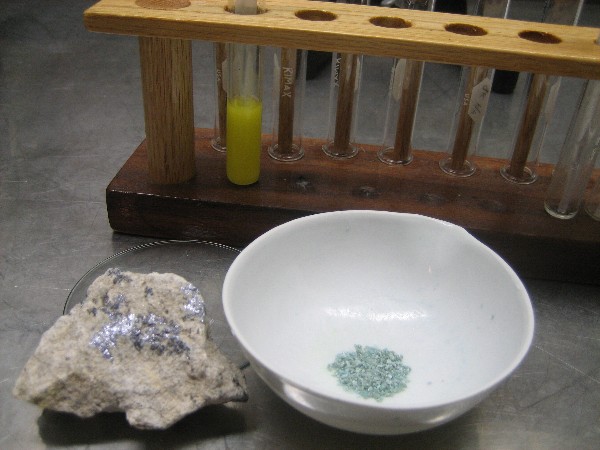Magpie
lab constructor
    
Posts: 5939
Registered: 1-11-2003
Location: USA
Member Is Offline
Mood: Chemistry: the subtle science.
|
|
some molybdenum chemistry
I have an old high school chemistry text (1923) that describes a test for phosphate using ammonium molybdate. A positive test gives a yellow
precipitate of ammonium phosphomolybdate.
Having some molybdenite ore I decided to try my hand at making some ammonium molybdate using the procedure in "Inorganic Preparations," by Walton in
the forum library.
I ground up some flakes of MoS2 scraped from a chunk of ore. This was then roasted at a dull red heat in a small crucible using a bunsen burner.
This yielded MoO3. Treating with NH4OH yielded the (NH4)2MoO4. This is shown in the photo as clear crystals. The blue is due to contamination,
possibly MoO2.
The test tube shows the brilliant yellow of the positive test on a phosphate solution.
I didn't get near the yield of crystals I expected. I believe that I may have had the crucible too hot, driving off significant MoO3 as a vapor.
However, the weight reduction from MoS2 --> MoO3 was very near theoretical.
If anyone is interested in the 1923 procedure for the test for phosphate I will be glad to post it.
A UNESCO website says the test is good for detection of phosphate in water down to 2.4 mg/L, or 2.5 x 10^-5M. It also provides the following
reaction:
Na2HPO4(aq) + 12(NH4)2MoO4(aq) --->(NH4)3PMo12O40(s)
+ 2NaNO3(aq) + 21NH4NO3(aq) + 12H2O(l)
[Edited on 7-3-2009 by Magpie]

|
|
|
DJF90
International Hazard
    
Posts: 2266
Registered: 15-12-2007
Location: At the bench
Member Is Offline
Mood: No Mood
|
|
Its a fairly sensitive test, and I'm not entirely sure, but I beleive it can be used to quantitatively measure the phosphate concentration of a water
sample by gravimetric analysis. Any known use for the resulting phosphomolybdate?
[Edited on 8-3-2009 by DJF90]
|
|
|
Magpie
lab constructor
    
Posts: 5939
Registered: 1-11-2003
Location: USA
Member Is Offline
Mood: Chemistry: the subtle science.
|
|
I'm surprised to hear that it can be quantitative as the 1923 text says that the composition of the ppt varies depending on temperature. But then the
UNESCO site doesn't say anything about that. So maybe in the past 86 years we learned something.
I have no idea if the yellow ppt has any other use.
[Edited on 7-3-2009 by Magpie]
|
|
|
Paddywhacker
Hazard to Others
  
Posts: 478
Registered: 28-2-2009
Member Is Offline
Mood: No Mood
|
|
Phosphomolybdate?
I'm scratching my head here and recalling from decades ago, but isn't there a sensitive quantitative test for phosphate that forms phosphomolybdate
and then reduces it to something with a blue colour that can be measured photometrically?
Edit:
Confirmed by Google.
Here is a query about testing for phosphate in aquarium water
http://www.thereeftank.com/forums/f6/question-about-phosphat...
Maybe the original poster can reduce the bulk compound and isolate the blue stuff, whatever it is.
[Edited on 8-3-2009 by Paddywhacker]
|
|
|
DJF90
International Hazard
    
Posts: 2266
Registered: 15-12-2007
Location: At the bench
Member Is Offline
Mood: No Mood
|
|
If the test is quantitative and requires proceeding though the phosphomolybdate, this suggests its precipitation is also quantitative, and in such a
case, would it not be easier to preform gravimetric analysis rather than reduction to another compound and then photometric analysis (providing you
have a decent balance... which is more likely to be in your posession than a photospectrometer).
|
|
|
unionised
International Hazard
    
Posts: 5126
Registered: 1-11-2003
Location: UK
Member Is Offline
Mood: No Mood
|
|
I think those were the days where you used your eyes rather than a spectrophotometer. Also, a lot of those colour reactions will work down to a few
micrograms. How good is your balance?
|
|
|